The Role of Organizations in Corporate Social Responsibility (CSR)
VerifiedAdded on 2022/09/01
|6
|845
|22
Report
AI Summary
This report delves into the roles of the government, nonprofit organizations, and for-profit organizations in extending the concept of Corporate Social Responsibility (CSR). It highlights the need for effective collaboration between these entities to address pressing social issues like world hunger, infrastructure problems, and climate change. The report examines the barriers to successful collaboration, such as funding limitations, public awareness, and diversity. It analyzes the government's role in CSR, including the need for public awareness programs and capacity building. It also explores the role of for-profit organizations in creating value for stakeholders and the challenges they face. Finally, it examines the contribution of nonprofit organizations in extending the CSR concept through transparency, effective governance, and communication. The report concludes that a strong union between these institutions is crucial to overcoming CSR challenges.
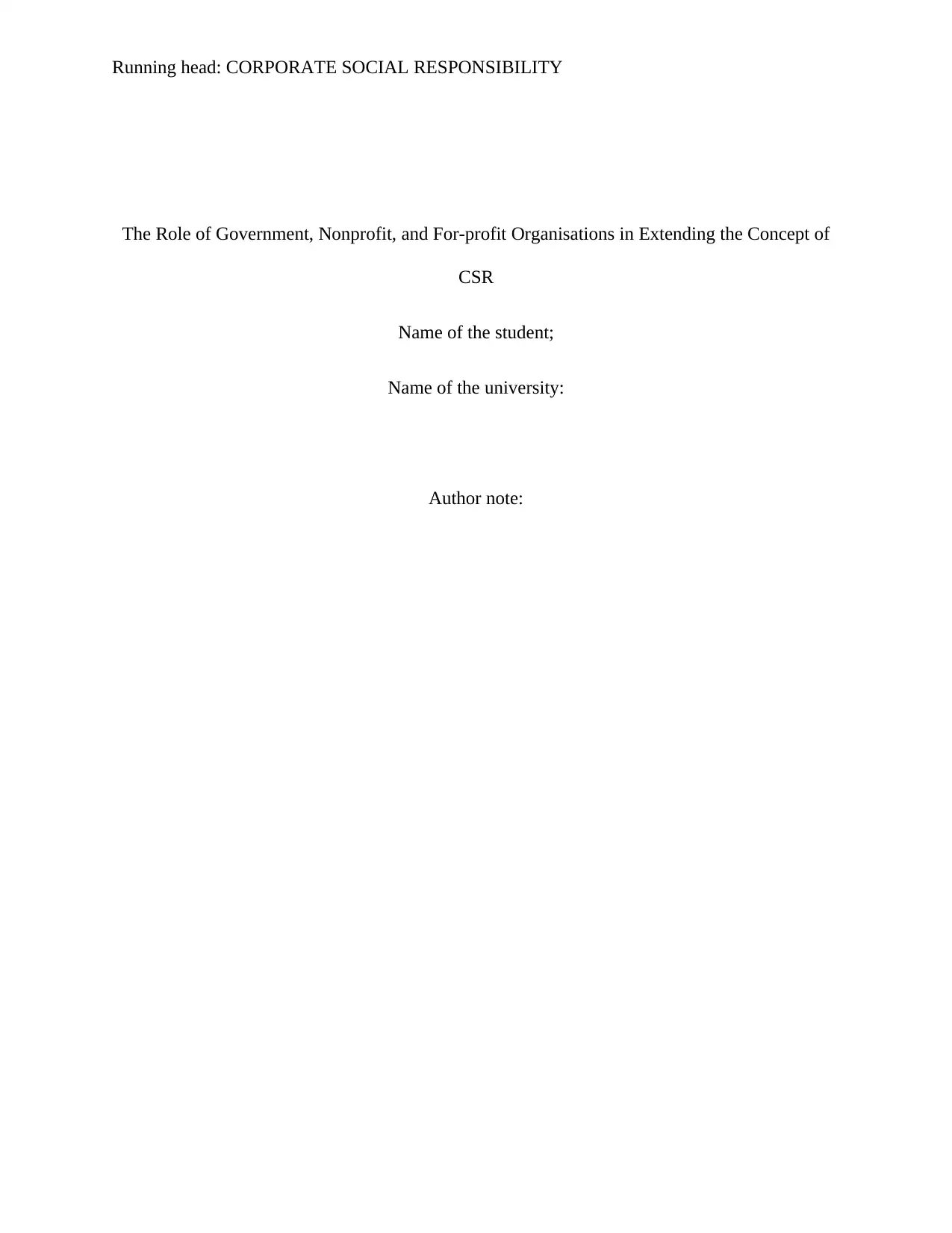
Running head: CORPORATE SOCIAL RESPONSIBILITY
The Role of Government, Nonprofit, and For-profit Organisations in Extending the Concept of
CSR
Name of the student;
Name of the university:
Author note:
The Role of Government, Nonprofit, and For-profit Organisations in Extending the Concept of
CSR
Name of the student;
Name of the university:
Author note:
Paraphrase This Document
Need a fresh take? Get an instant paraphrase of this document with our AI Paraphraser
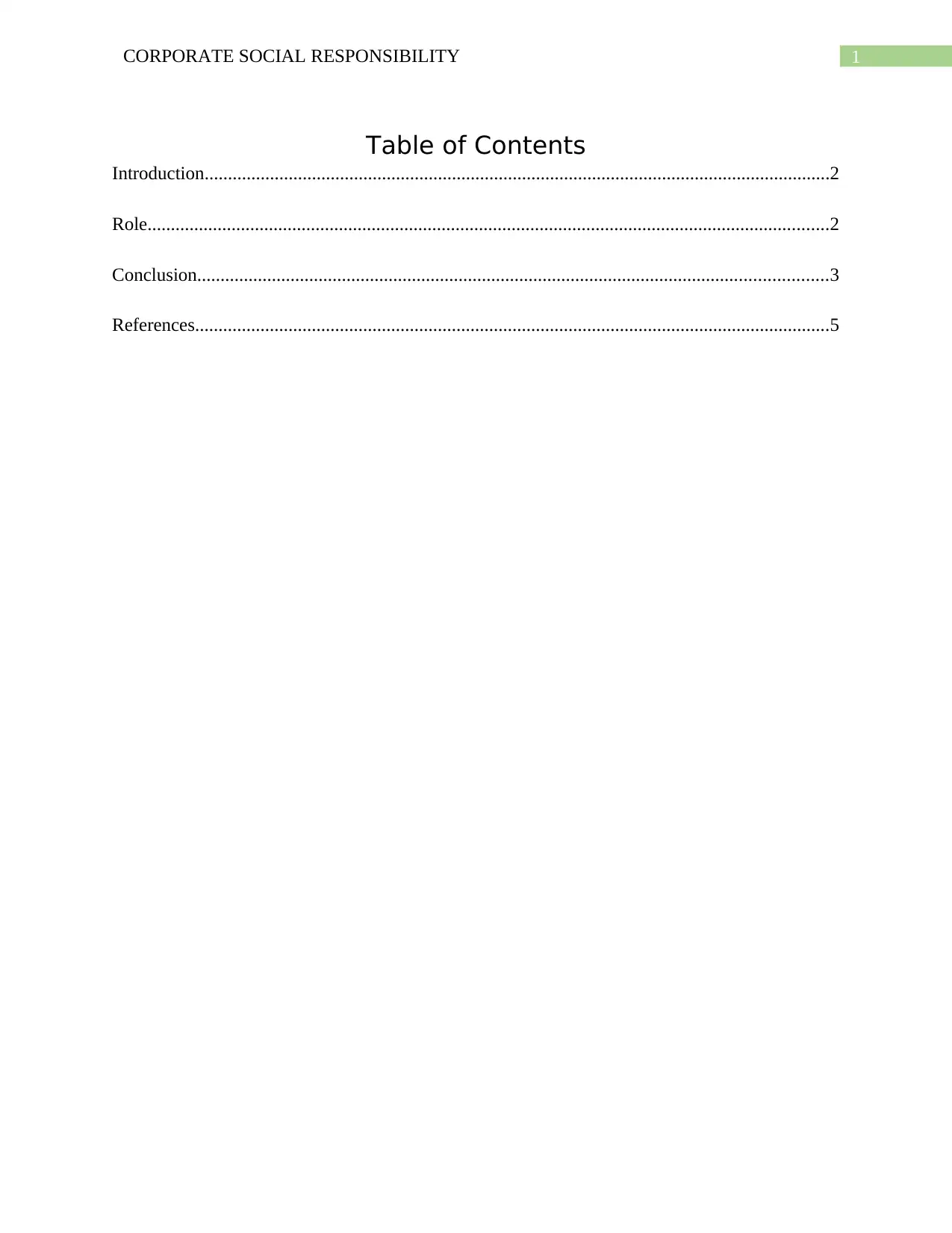
1CORPORATE SOCIAL RESPONSIBILITY
Table of Contents
Introduction......................................................................................................................................2
Role..................................................................................................................................................2
Conclusion.......................................................................................................................................3
References........................................................................................................................................5
Table of Contents
Introduction......................................................................................................................................2
Role..................................................................................................................................................2
Conclusion.......................................................................................................................................3
References........................................................................................................................................5
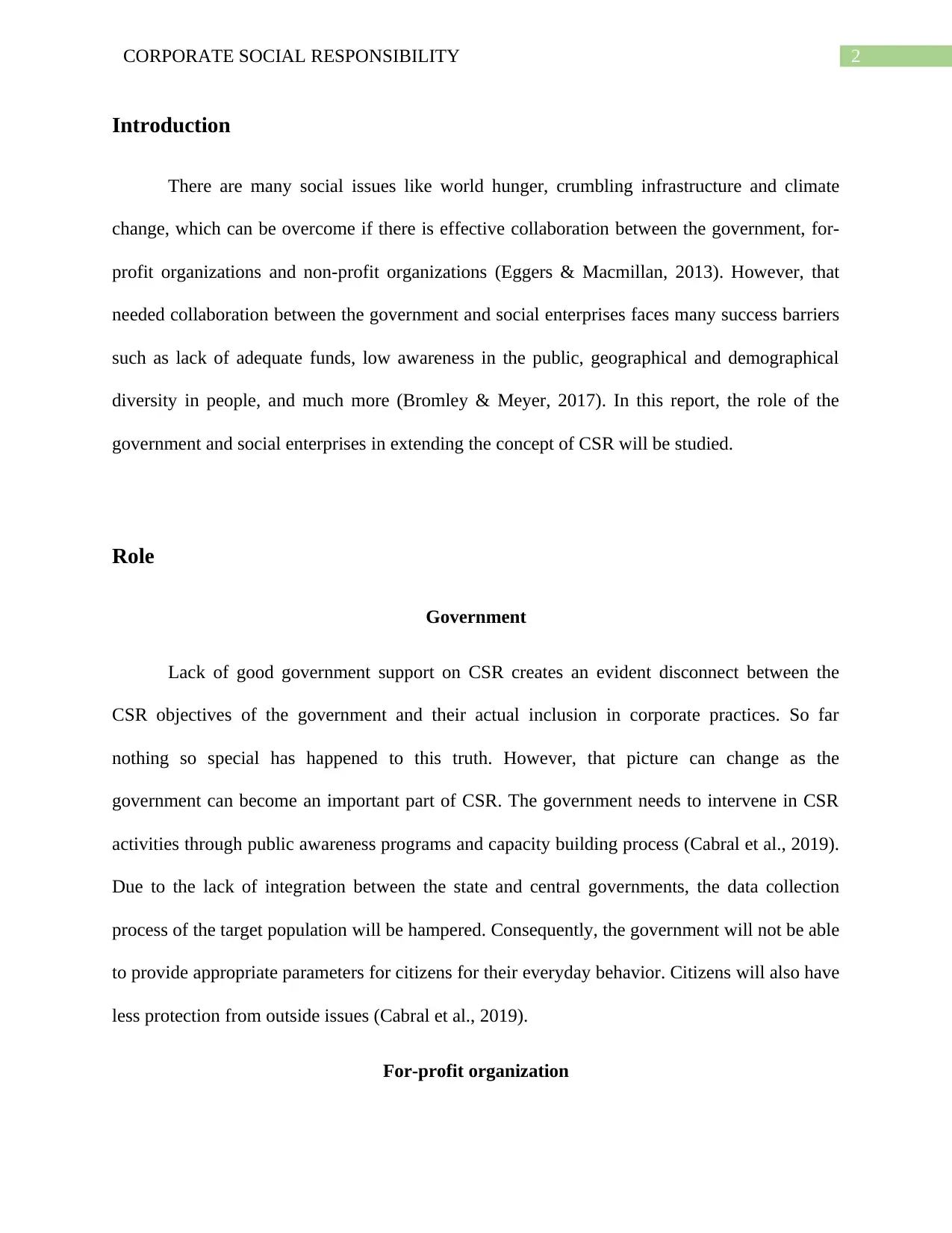
2CORPORATE SOCIAL RESPONSIBILITY
Introduction
There are many social issues like world hunger, crumbling infrastructure and climate
change, which can be overcome if there is effective collaboration between the government, for-
profit organizations and non-profit organizations (Eggers & Macmillan, 2013). However, that
needed collaboration between the government and social enterprises faces many success barriers
such as lack of adequate funds, low awareness in the public, geographical and demographical
diversity in people, and much more (Bromley & Meyer, 2017). In this report, the role of the
government and social enterprises in extending the concept of CSR will be studied.
Role
Government
Lack of good government support on CSR creates an evident disconnect between the
CSR objectives of the government and their actual inclusion in corporate practices. So far
nothing so special has happened to this truth. However, that picture can change as the
government can become an important part of CSR. The government needs to intervene in CSR
activities through public awareness programs and capacity building process (Cabral et al., 2019).
Due to the lack of integration between the state and central governments, the data collection
process of the target population will be hampered. Consequently, the government will not be able
to provide appropriate parameters for citizens for their everyday behavior. Citizens will also have
less protection from outside issues (Cabral et al., 2019).
For-profit organization
Introduction
There are many social issues like world hunger, crumbling infrastructure and climate
change, which can be overcome if there is effective collaboration between the government, for-
profit organizations and non-profit organizations (Eggers & Macmillan, 2013). However, that
needed collaboration between the government and social enterprises faces many success barriers
such as lack of adequate funds, low awareness in the public, geographical and demographical
diversity in people, and much more (Bromley & Meyer, 2017). In this report, the role of the
government and social enterprises in extending the concept of CSR will be studied.
Role
Government
Lack of good government support on CSR creates an evident disconnect between the
CSR objectives of the government and their actual inclusion in corporate practices. So far
nothing so special has happened to this truth. However, that picture can change as the
government can become an important part of CSR. The government needs to intervene in CSR
activities through public awareness programs and capacity building process (Cabral et al., 2019).
Due to the lack of integration between the state and central governments, the data collection
process of the target population will be hampered. Consequently, the government will not be able
to provide appropriate parameters for citizens for their everyday behavior. Citizens will also have
less protection from outside issues (Cabral et al., 2019).
For-profit organization
⊘ This is a preview!⊘
Do you want full access?
Subscribe today to unlock all pages.

Trusted by 1+ million students worldwide
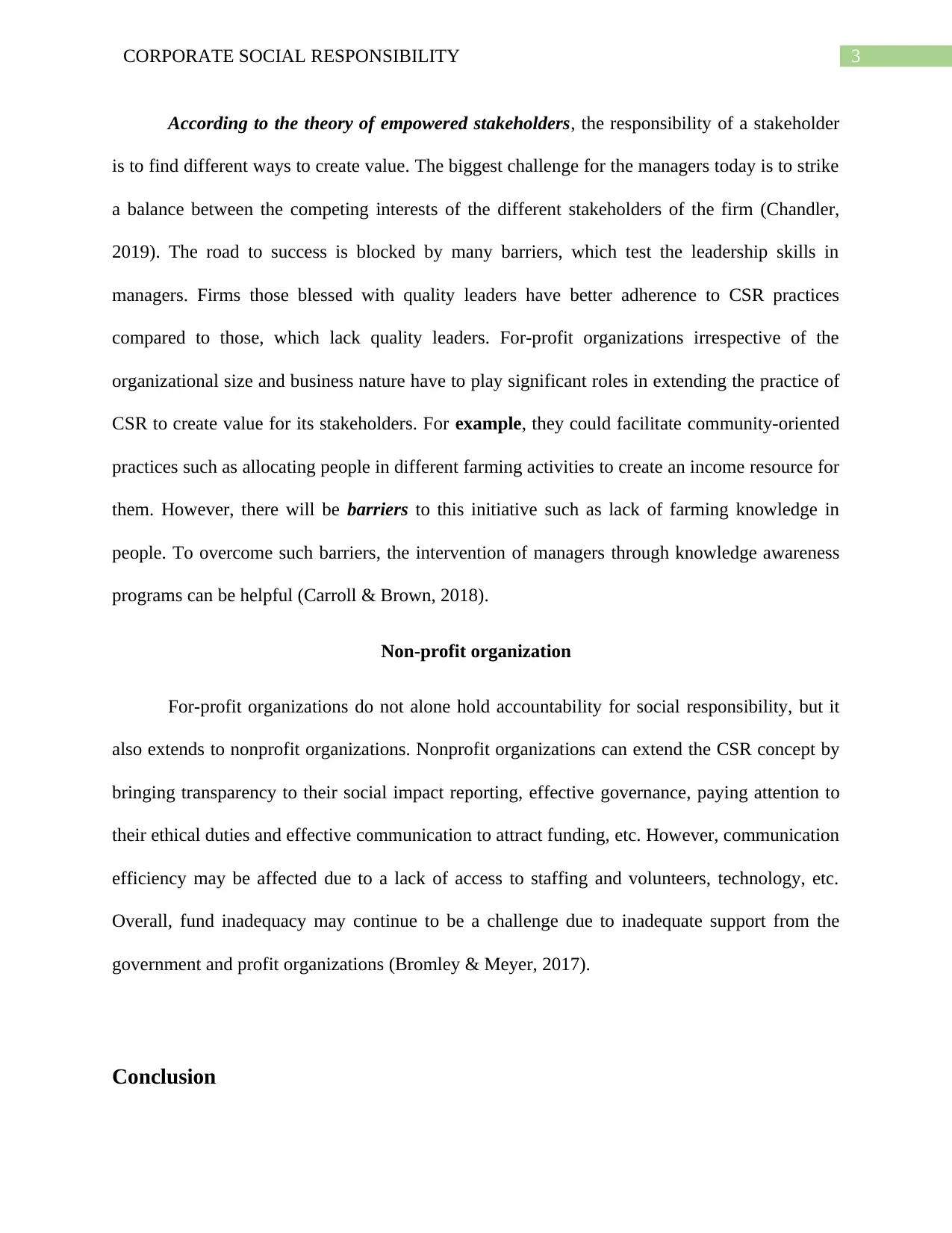
3CORPORATE SOCIAL RESPONSIBILITY
According to the theory of empowered stakeholders, the responsibility of a stakeholder
is to find different ways to create value. The biggest challenge for the managers today is to strike
a balance between the competing interests of the different stakeholders of the firm (Chandler,
2019). The road to success is blocked by many barriers, which test the leadership skills in
managers. Firms those blessed with quality leaders have better adherence to CSR practices
compared to those, which lack quality leaders. For-profit organizations irrespective of the
organizational size and business nature have to play significant roles in extending the practice of
CSR to create value for its stakeholders. For example, they could facilitate community-oriented
practices such as allocating people in different farming activities to create an income resource for
them. However, there will be barriers to this initiative such as lack of farming knowledge in
people. To overcome such barriers, the intervention of managers through knowledge awareness
programs can be helpful (Carroll & Brown, 2018).
Non-profit organization
For-profit organizations do not alone hold accountability for social responsibility, but it
also extends to nonprofit organizations. Nonprofit organizations can extend the CSR concept by
bringing transparency to their social impact reporting, effective governance, paying attention to
their ethical duties and effective communication to attract funding, etc. However, communication
efficiency may be affected due to a lack of access to staffing and volunteers, technology, etc.
Overall, fund inadequacy may continue to be a challenge due to inadequate support from the
government and profit organizations (Bromley & Meyer, 2017).
Conclusion
According to the theory of empowered stakeholders, the responsibility of a stakeholder
is to find different ways to create value. The biggest challenge for the managers today is to strike
a balance between the competing interests of the different stakeholders of the firm (Chandler,
2019). The road to success is blocked by many barriers, which test the leadership skills in
managers. Firms those blessed with quality leaders have better adherence to CSR practices
compared to those, which lack quality leaders. For-profit organizations irrespective of the
organizational size and business nature have to play significant roles in extending the practice of
CSR to create value for its stakeholders. For example, they could facilitate community-oriented
practices such as allocating people in different farming activities to create an income resource for
them. However, there will be barriers to this initiative such as lack of farming knowledge in
people. To overcome such barriers, the intervention of managers through knowledge awareness
programs can be helpful (Carroll & Brown, 2018).
Non-profit organization
For-profit organizations do not alone hold accountability for social responsibility, but it
also extends to nonprofit organizations. Nonprofit organizations can extend the CSR concept by
bringing transparency to their social impact reporting, effective governance, paying attention to
their ethical duties and effective communication to attract funding, etc. However, communication
efficiency may be affected due to a lack of access to staffing and volunteers, technology, etc.
Overall, fund inadequacy may continue to be a challenge due to inadequate support from the
government and profit organizations (Bromley & Meyer, 2017).
Conclusion
Paraphrase This Document
Need a fresh take? Get an instant paraphrase of this document with our AI Paraphraser

4CORPORATE SOCIAL RESPONSIBILITY
By investigating a few roles of the government, nonprofit organizations and profit
organizations in extending the CSR concept, it was being found that there will be many
difficulties for each of the institutions. Until and unless there is a strong union between these
institutions, the CSR challenges might not be overcome.
By investigating a few roles of the government, nonprofit organizations and profit
organizations in extending the CSR concept, it was being found that there will be many
difficulties for each of the institutions. Until and unless there is a strong union between these
institutions, the CSR challenges might not be overcome.
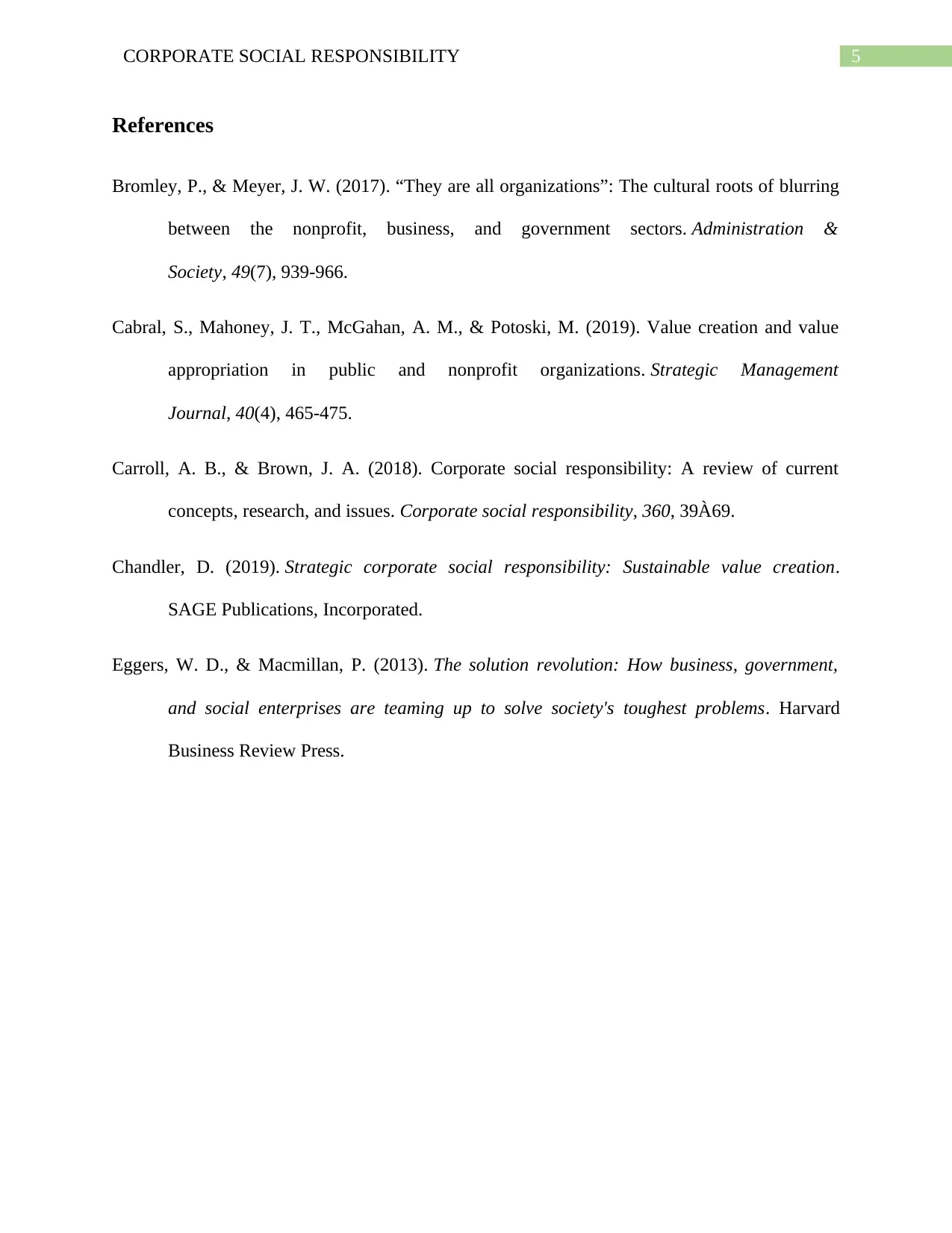
5CORPORATE SOCIAL RESPONSIBILITY
References
Bromley, P., & Meyer, J. W. (2017). “They are all organizations”: The cultural roots of blurring
between the nonprofit, business, and government sectors. Administration &
Society, 49(7), 939-966.
Cabral, S., Mahoney, J. T., McGahan, A. M., & Potoski, M. (2019). Value creation and value
appropriation in public and nonprofit organizations. Strategic Management
Journal, 40(4), 465-475.
Carroll, A. B., & Brown, J. A. (2018). Corporate social responsibility: A review of current
concepts, research, and issues. Corporate social responsibility, 360, 39À69.
Chandler, D. (2019). Strategic corporate social responsibility: Sustainable value creation.
SAGE Publications, Incorporated.
Eggers, W. D., & Macmillan, P. (2013). The solution revolution: How business, government,
and social enterprises are teaming up to solve society's toughest problems. Harvard
Business Review Press.
References
Bromley, P., & Meyer, J. W. (2017). “They are all organizations”: The cultural roots of blurring
between the nonprofit, business, and government sectors. Administration &
Society, 49(7), 939-966.
Cabral, S., Mahoney, J. T., McGahan, A. M., & Potoski, M. (2019). Value creation and value
appropriation in public and nonprofit organizations. Strategic Management
Journal, 40(4), 465-475.
Carroll, A. B., & Brown, J. A. (2018). Corporate social responsibility: A review of current
concepts, research, and issues. Corporate social responsibility, 360, 39À69.
Chandler, D. (2019). Strategic corporate social responsibility: Sustainable value creation.
SAGE Publications, Incorporated.
Eggers, W. D., & Macmillan, P. (2013). The solution revolution: How business, government,
and social enterprises are teaming up to solve society's toughest problems. Harvard
Business Review Press.
⊘ This is a preview!⊘
Do you want full access?
Subscribe today to unlock all pages.

Trusted by 1+ million students worldwide
1 out of 6
Related Documents
Your All-in-One AI-Powered Toolkit for Academic Success.
+13062052269
info@desklib.com
Available 24*7 on WhatsApp / Email
![[object Object]](/_next/static/media/star-bottom.7253800d.svg)
Unlock your academic potential
Copyright © 2020–2025 A2Z Services. All Rights Reserved. Developed and managed by ZUCOL.




